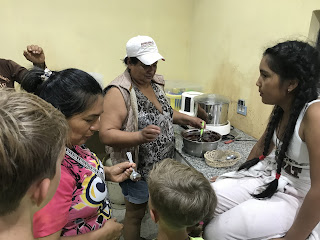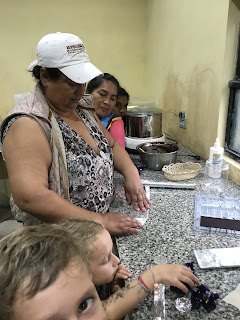The Chocolate Factory
 |
| Lucia and Sandy enjoying a taste of chocolate; Galo, our guide, in the background |
Each cacao, a pod-shaped fruit about the size and shape of an American football (though narrower; and with grooves), produces 35 to 50 seeds surrounded by a sweet, tangy pulp. The pulp is absolutely delicious to suck on. It rivals our oranges as Brynna’s favorite local fruit. While my whole family loves eating the fruit, it is the seeds of the cacao that are valuable to the farmer. So valuable, in fact, that when we eat the fruit, we always preserve the seeds.
Cacao has long been a regional cash crop. After harvest, the cacao pod is opened by the farmer with a machete, the seeds are removed by hand and then dried on cement patios or along the sides of roads before being sold to middlemen and chocolate producers. The current rate is $12 USD for a 20-gallon bucket of cacao seeds.
ASOPROCANAM is aiming to make several major changes in how cacao is grown and sold in the region.
First, they are trying to incentivize organic farming. Organic farming -- a system of agriculture and food production that does not use synthetic fertilizers or pesticides -- is not the norm here. From bananas, to cattle feed, to cacao, it is standard practice for local farmers to fumigate their crops with abandon. Quite honestly, it is hard to blame them; the land is so productive that weeds and food crops grow side by side at breakneck speed. Also, insects and other pests are rampant in the tropics. It takes commitment, knowledge, and novel techniques for farmers to grow organic crops successfully. And it takes a market for a product that is different from what is traditionally known.
Farmers need to be taught to manage their crops without the use of pesticides and other synthetic interventions. They also need to believe that it is worth their time. On average, it takes a cacao tree five years from seed to produce fruit. It is a long investment for farmers to tend to plants for five years before reaping benefits.
Second, ASOPROCANAM is aiming to create high quality cacao that can be exported to foreign markets as a reliable and stable income stream for local farmers. In order to accomplish this, each farm (very small plots, still very much family-owned and run) must be certified as organic, a process which can take several years. As a relatively new organization, they also have to build relationships with vendors and distributors to ensure that their cacao does, indeed, have a reliable market.
Third, ASOPROCANAM is trying to learn how to make consumable chocolate products. This is, not surprisingly, our favorite part of the operation -- the kitchen. While it is a small part of current facility, there are committed members of the organization experimenting in understanding how to convert toasted cacao into a delicious chocolate bars, hot chocolate mixes, and bon bons for sale. I definitely do not mind being a taste tester in their test kitchen. They are experimenting with using sugar vs. panela to sweeten their chocolate, creating a variety of different dark chocolate percentages, and even making cacao-shelled tea, which is almost like a caffeinated energy drink.
Needless to say, our family has visited the Chocolate Factory three times since we first heard about it, and I imagine we will take more visitors there in the future. I am also certain we are their most frequent visitors, as it is a little operation that is barely marked on the side of a rural road.
It is a sweet set of operations, and super cool to see how the delicious fruit we love to pick in the finca is converted into delicious chocolate bars we can munch on after dinner. Plus, we have learned a lot about fermentation, toasting, and the whole process of chocolate production. In Sonoma County, people talk a lot about farm to table eating. . . what about chocolate farm to table too? Pretty cool.
See the photos below to understand some of the steps of cacao processing on its way to becoming that delicious chocolate bar you are just about to open to share with the ones you love.
 |
| The inside of the cacao seed after fermentation before drying |
 |
| Fermented seeds are now dried under a heat lamp for about 7 days in these frames |


 | ||
| Cacao sorter, sorts out seeds that are too big or too small after drying |
 |
| Mechanical cacao dryer, which has temperature regulator and allows for more standardized drying after fermentation |
 |
| Sacks of fermented, dried cacao ready for export to Switzerland |
 |
| Paul's favorite homemade contraption, separates roasted cacao seeds from the shells/peel using a shop-vac |
 |
| Galo explaining that the nibs are now separated and ready for grinding -- in the machine right behind him, which produces a grainy paste of peanut-butter consistency (quite bitter!) |
 |
| Chocolate fine-grinder, takes the chocolate from a paste to a thick, smooth melted chocolate over the course of 24+ hrs. Sweetener is added depending on desired % |

















How chocolate was invented in the preindustrial world amazes me. Same for coffee while we are on the subject. Hope there is a sufficient market for the organic product; so much better for farmers and land. (FB)
ReplyDelete